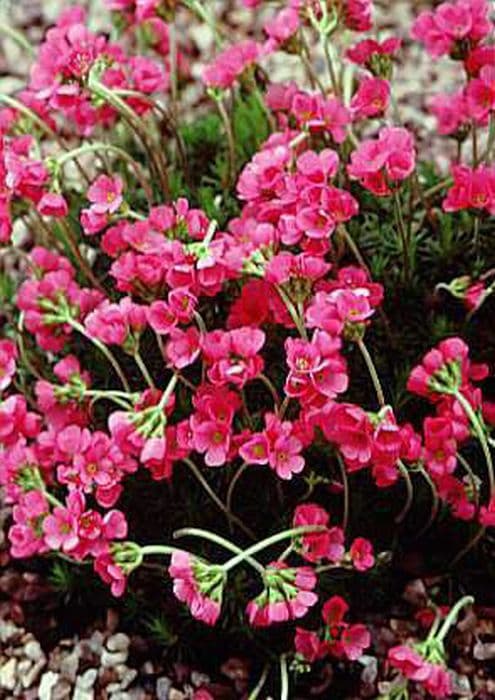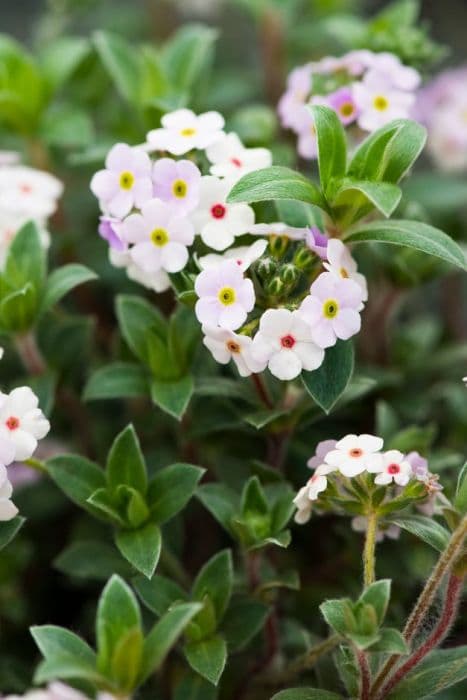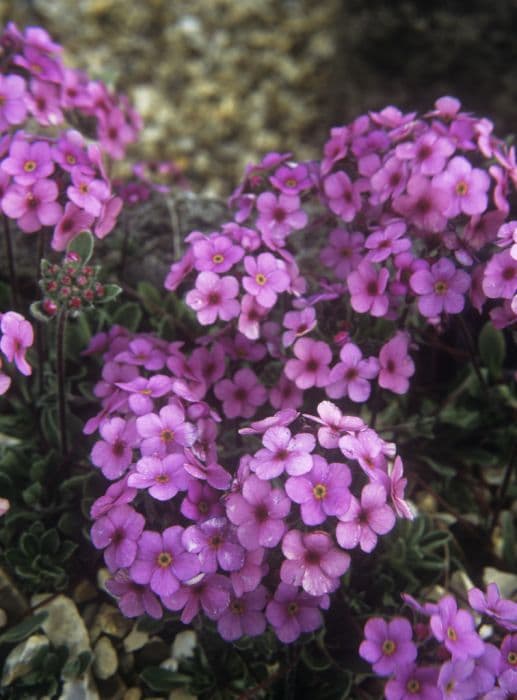Bear's ear Primula auricula 'Eden Goldfinch' (Au/b)

ABOUT
Primula auricula 'Eden Goldfinch', commonly known as the Auricula or Bear's Ear, is a captivating perennial plant that features a distinctly ornamental appeal. This variety is particularly celebrated for its striking flowers, which are a rich, vibrant yellow, often with a tiny splash of red or orange at the very center, radiating warmth and cheerfulness in the garden. These blossoms form dense, round clusters at the top of sturdy, upright stems that emerge from a rosette of leaves. The leaves themselves are noteworthy, being fleshy, with a somewhat velvety texture, and a pale green hue, which can sometimes be accentuated by a powdery white coating that adds to their unique appearance. The flowers of the 'Eden Goldfinch' exude an exquisite charm with their rounded shape and brightly colored petals, drawing the eyes of passersby and serving as a stark contrast to the more muted tones of the surrounding foliage. The overall impression that Primula auricula 'Eden Goldfinch' imparts is one of a well-structured, colorful, and lush addition to any garden setting, perfect for borders or as a focal point amongst other spring-blooming flowers.
About this plant
 Names
NamesFamily
Primulaceae.
Synonyms
Bear's Ear Auricula, Mountain Cowslip, Auricula, Bear's Ear Primrose.
Common names
Primula auricula 'Eden Goldfinch' (Au/b).
 Toxicity
ToxicityTo humans
The Auricula, a type of Primula, is not considered highly toxic to humans. However, ingestion can cause mild symptoms, including nausea, vomiting, and diarrhea. Contact with the skin can sometimes result in dermatitis due to the presence of primin, a potential skin irritant found in the plant. It is important to handle Auriculas with care and wash your hands afterward, especially if you have sensitive skin. If ingested, the consumption of the Auricula is unlikely to be fatal, but seeking medical advice is recommended if symptoms persist or if there is any concern.
To pets
The Auricula may cause mild to moderate toxicity in pets if ingested. The symptoms of Auricula poisoning in pets may include vomiting, drooling, diarrhea, and possible dermatitis if there is skin contact. Primin, the irritant compound found in Auriculas, can affect pets similarly to humans when it comes to skin exposure. Pet owners should prevent their animals from ingesting any part of the plant and consult a veterinarian if they suspect their pet has consumed Auricula.
 Characteristics
CharacteristicsLife cycle
Perennials
Foliage type
Evergreen
Color of leaves
Green
Flower color
Yellow
Height
6 inches (15 cm)
Spread
6 inches (15 cm)
Plant type
Herb
Hardiness zones
5
Native area
Europe
Benefits
 General Benefits
General Benefits- Ornamental Value - The Primula auricula 'Eden Goldfinch', commonly known as Auricula, has unique and vibrant flowers that add visual interest to gardens and landscapes.
- Extended Blooming - Auriculas have a long flowering period, from early spring through late spring, providing color in the garden when many other plants are not in bloom.
- Compact Size - Being a smaller plant, it fits well in rock gardens, borders, and small spaces, making it ideal for those with limited gardening space.
- Drought Tolerance - Once established, Auriculas are somewhat drought-tolerant, requiring less frequent watering than many other garden plants.
- Cold Hardy - The plant is relatively cold-hardy, making it suitable for cultivation in cooler climates where it can survive and thrive.
- Attracts Pollinators - Auricula flowers are known to attract bees and butterflies, helping to pollinate other plants in the garden.
- Container Gardening - Suitable for container cultivation, Auriculas can be grown on patios, balconies, or indoors with adequate light.
 Medical Properties
Medical PropertiesThis plant is not used for medical purposes.
 Air-purifying Qualities
Air-purifying QualitiesThis plant is not specifically known for air purifying qualities.
 Other Uses
Other Uses- Auricula 'Eden Goldfinch' can be used in alpine rock gardens for its ability to adapt in crevices and rockeries, adding vibrant color accents.
- This plant's unique appearance allows it to be suitable for inclusion in botanical art and illustration projects.
- The natural shape and form of Auricula 'Eden Goldfinch' lends itself well to being featured in photography, especially macro photography, owing to its intricate patterns.
- Its compact size makes it an ideal candidate for fairy and miniature gardens, which are a whimsical addition to both outdoor and indoor spaces.
- The plant's brightly colored flowers can serve as inspiration for designers and artists in color palette development.
- Auricula 'Eden Goldfinch' can be used in educational settings as a specimen plant to teach botany and horticulture, given its unique characteristics.
- It is also used in the practice of companion planting, where its presence can help deter certain pests naturally in gardens.
- The plant can be utilized as a live model in clay and porcelain flower-making classes for crafting realistic floral replicas.
- Floral arrangements designed for aesthetic or competitive displays often make use of Auricula 'Eden Goldfinch' due to its vibrant colors and distinctive form.
- It can be incorporated into cultural events and festivals, particularly those celebrating spring, to emphasize themes of renewal and beauty.
Interesting Facts
 Feng Shui
Feng ShuiThe Auricula is not used in Feng Shui practice.
 Zodiac Sign Compitability
Zodiac Sign CompitabilityThe Auricula is not used in astrology practice.
 Plant Symbolism
Plant Symbolism- Youthful Glamour: The bright and alluring colors of the Primula, also known as Auricula, are often associated with the vibrancy and enchantment of youth.
- Perseverance and Resilience: Auriculas are known for their ability to endure colder climates and bloom early in spring, representing the qualities of perseverance and resilience in facing adversity.
- Constant Friendship: Due to their tendency to grow in clusters, Auriculas symbolize the close-knit bonds of friendship that remain constant over time.
- Patience: As a plant that requires careful attention and cultivation, the Auricula symbolizes patience and the rewards that come from diligent care.
- Unique Beauty: The unique and varied patterns of Auriculas, with their striking colors and intriguing shapes, stand for the beauty of individuality and the appreciation of uniqueness.
 Water
WaterFor Primula auricula 'Eden Goldfinch', often known as Auricula, water carefully to maintain evenly moist soil, especially during active growth in the spring and fall. Allow the top inch of soil to dry out slightly before watering again. Water approximately once every week, but adjust according to temperature and humidity. Use lukewarm water and avoid wetting the foliage to prevent fungal diseases. An approximate amount would be around 1 gallon per week for an outdoor plant, but ensure proper drainage to prevent waterlogging.
 Light
LightAuriculas like Primula auricula 'Eden Goldfinch' prefer bright but indirect light. A north-facing window or a spot that receives morning light with shade in the afternoon would be ideal. Avoid placing them in full sun, especially during the hottest parts of the day, as this can scorch their leaves.
 Temperature
TemperatureAuricula 'Eden Goldfinch' thrives in cooler temperatures, ideally between 50°F and 75°F. They can survive brief periods outside this range, with a minimum temperature of around 40°F and a maximum of about 80°F. Consistently cool temperatures will promote the best growth and flowering.
 Pruning
PruningPrune Auriculas like 'Eden Goldfinch' to remove dead or fading flowers and to encourage a second bloom. This is typically done after the initial spring flowering. Also, remove dead leaves to maintain good airflow and reduce the risk of disease. The best time for pruning is immediately after flowering.
 Cleaning
CleaningAs needed
 Soil
SoilThe Bear's Ear auricula prefers a well-draining soil mix consisting of equal parts peat, loam, and leaf mold with added perlite for aeration. A pH between 6.0 and 7.0 is optimal for healthy growth.
 Repotting
RepottingBear's Ear auriculas should be repotted every one to two years, ideally after they finish blooming in the spring.
 Humidity & Misting
Humidity & MistingBear's Ear auriculas thrive in moderate humidity levels, ideally between 50-60%, avoiding excessively dry or damp conditions.
 Suitable locations
Suitable locationsIndoor
Place in bright, indirect light and keep soil moist.
Outdoor
Plant in partial shade, shelter from strong winds and heavy rain.
Hardiness zone
4-8 USDA
 Life cycle
Life cyclePrimula auricula 'Eden Goldfinch' (Au/b), commonly known as Auricula, begins its life cycle as a seed, typically sown in late winter or early spring in well-draining, moist soil with partial shade. Upon germination, it grows into a seedling and develops a rosette of leaves at the base. As the plant matures, it develops a flowering stalk in mid to late spring, adorned with clusters of brightly colored, often yellow-edged flowers. After pollination, often by insects, the flowers will produce seed pods that ripen, at which point the plant can be deadheaded to encourage more blooms or allowed to set seed. During the summer, the Auricula may enter a period of dormancy, especially in hotter climates, and it requires less water during this stage. The plant is perennial, which means after the growing season it will die back and then re-sprout from the same root system the following spring, repeating its life cycle.
 Propogation
PropogationPropogation time
Spring to summer
Primula auricula 'Eden Goldfinch', often referred to simply as Auricula, can be propagated most effectively through division. The optimal time for dividing Auricula plants is in late summer, after they have finished flowering. This allows the divisions to establish roots and acclimatize before the onset of winter. To propagate by division, carefully lift the parent plant from the ground, ensuring a generous amount of root is intact. Using a clean, sharp knife or spade, split the clump into smaller sections, each with several shoots and a portion of the root system. Replant the divisions at the same depth they were growing previously, spacing them approximately 6 inches (15 centimeters) apart to allow room for growth. Water the new divisions thoroughly to settle the soil around the roots and maintain even moisture until they show signs of new growth, indicating successful establishment.









